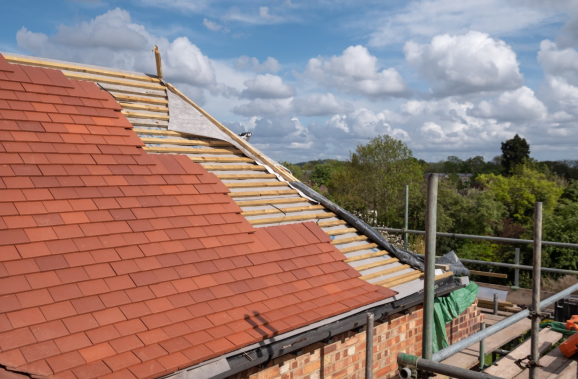Understanding the various types of roof damage can benefit property owners by enabling early detection of issues, preventing them from escalating into more severe and costly problems. In this article, we aim to help you understand the various types of roof damage that can occur, the signs to look out for and the most effective way to maintain or repair roofs. This knowledge should benefit you financially and potentially extend your roof's life.
Different Types Of Roof Damage
There are too many different types of roof damage to list in this article. We have outlined some of the more common ones associated with properties in the UK.
- Leaks: During highly wet weather, persistent rain can lead to leaks and mould damage.
- Flashing Issues: Flashing damage is a common issue, often caused by age, poor installation, high winds, or UV exposure to the sealant.
- Storm Damage: During strong winds, roofing materials can dislodge or blow away, often due to missing or worn-out supporting materials.
- Hail Damage: Less common, but hail damage can damage metal roofs and sometimes tiles.
- Structural: damage is often caused by poor workmanship, subsidence, or material wear over time. It can result in sagging roofs, cracks, or even complete roof failure.
Material Damage
Roofs can be made from many different materials. Each has its unique vulnerability to potential damage.
- Tiles: Due to the diverse materials tiles can be made from, they can be damaged in many ways. Common problems include cracking, chips, movement and fading. Weather and age are usually the most significant contributors to damage.
- Metal Roofs: Corrosion is one of the most common issues associated with metal roofing. Other damage-related problems include dents and even total roof loss due to wind and contraction-related issues (hot and cold expansion).
- Asphalt: A common issue associated with asphalt roofs is granular loss. The main problem with this scenario is that there is little to protect the shingles without the granules. Other asphalt damage includes blisters, cracking and curling at the corners. Weather, again, is the main instigator of damage.
- Wood can be quite susceptible to damage, especially if it has not been adequately maintained and looked after. The most common issues associated with wood are rot, insect damage and splitting. Regular roof maintenance is crucial.
- Chimney damage can take many forms. The most common are cracking, mortar-related issues, crown damage and leaning. The biggest problem for chimneys is usually age. Over time, the structure starts to degrade. Often, something as simple as chimney repointing is all that is required.
Roof Damage Indicators
Roof damage is often relatively easy to detect, with clear, evident signs. However, damage can sometimes be hidden within the structure, making it less noticeable. Below are some signs to look out for.
Internal
Internal damage is often the first sign of roof damage a homeowner will see. Especially if the roof is old and has not been maintained or inspected for a while. It would be prudent to look for the following indicators:
- Musty or mould smell, often with obvious signs of mould growing.
- Paint and wallpaper that is starting to peel are often caused by moisture.
- Water stains are coming down the ceiling.
- A sagging ceiling, often due to water collection, is associated with flat roofs.
- Drips and leaks are coming from the ceiling.
External
Signs to look out for that indicate external roof damage include:
- Roof materials that are dislodged or missing.
- Cracks or flaking tiles.
- Wood that is splitting or discoloured.
- Rusting materials such as metal roofs and fasteners.
- Blistering of the roof membrane.
- Areas of the roof that appear to be sagging.
- Overflowing drainpipes.
Surroundings
Signs of roof damage are not always on the roof or internal. Other indicators include:
- Parts of the roof on the floor, such as broken tiles or brackets.
- Moss on the exterior of walls.
- Exteria walls with peeling paint.
Tips For Insurance Claims
Making claims with insurance companies for roof-related damage can sometimes be complicated. Below are some tips to help make the process more efficient.
- Policy Terms: Fully understanding your terms and conditions will enable you to avoid non-payment, negotiate better, and process the claim more quickly.
- Documentation: It is good practice to record all interactions with the insurance company during the claim process. It can help create accountability and speed up interactions and the claim process. You will also have documentation if the matter goes to the courts.
- Meet Inspectors: It is often beneficial to meet the inspectors when they inspect the roof damage. It allows you to answer any questions as well as ask them. Another advantage is that you can ensure they view all damage and fully understand the situation.
- Understand Report: Often, the technical side of a report can be complex to understand. It is essential to understand all details to avoid any confusion about the repair work. They could also include recommendations for repair of the roof and descriptions of the damage.
- Seek Professional Help: If you are concerned about the report and the solution offered, contact a reputable roofing company such as Knights Roofing to talk you through your options.
Summary
Neglecting to maintain or repair a damaged roof can result in much more work later on. If you have any concerns regarding roof integrity and would like the advice of a roofing specialist company, contact us anytime for advice or a quote.




